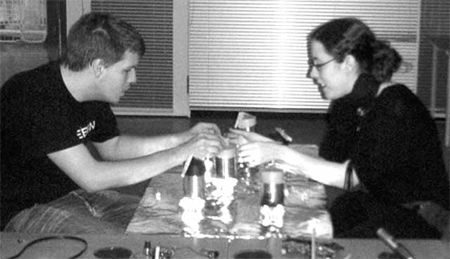
| Notes on "A Paramusical Experiment" at the Museum of Science and Industry |
 |
Museum of Science and Industry Performance “A Paramusical Experiment” This performance was for the 2007 Manchester festival of Science and took part in the Museum of Science and Industry. I had not really put forward a detailed proposal for the piece and basically ended up with a class-room for 3 hours to do something in. The context was interactive demonstrations of science, outside the room I had chosen were several stalls, police forensics, pond insects, a junk instrument workshop and bloke dressed as a roman centurion. So in the spirit of the event I decide to perform three, 1 hour long tests/experiments deploying various sets of my noise making devices. There was no structure to the piece other than to simply play and experiment. Accompanying me were Stefanie Wyke, Nichola Cunningham and Kalle Skagius. The first test was for steam machines, circuit bent radios and polystyrene + porcelain plates. It became apparent once we let people into the space that it would a quite different experience from pervious public performances of my work, particularly when you add lots of excited inquisitive children to the equation. Although I was pleased with the level of interest in the performance it was not really going to be an environment to make artwork in. It was difficult to concentrate on the performance and get a sense of what was happening whilst explaining what we were doing and making sure things didn't get out hand. I could have taken steps to control this but this was what the whole event was about. So although I was not really making any art as such it was useful to experiment with the devices and see people's responses. We also allowed visitors to contribute to clamour by using the polystyrene and radio circuitry. Listening back to the recordings it did create a sonic environment that worked in the way I wanted it to. Partly organic, environmental, like something you might experience in a jungle. A background throb of noise punctuated by intermittent bursts of squeals and rattles. Yet the source of sounds resonating with sense of the machine, man made. The set of devices really complimented each of other, definitely something to try out again. |
 |
Test two featured four turntable devices with Peizo Transducer styluses amplified and the signals sent to individual speakers. The turntables were playing CDRs, vinyl and plates combined or modified with scratches and blobs of glue. Before these were activated an intermission of damaged skipping CD's played recordings of the circuit bent radios that acted as a transition between setups. This part of the performance was quite loud and challenging and consequently our number of visitors dwindled. It was also what I felt was the most successful part of the performance. The piece was largely automatous, setting up surfaces and letting them run whilst adjusting the EQ of the signals to bring out particular qualities in the noises produced. It created something dense and immersive, like being on the factory floor in some heavy industrial process. The range of sounds produced was quite varied, rhythmical growls, percussive clicks, jagged barks and sheets of furry noise. Prolonged exposure to the piece changed its effect, initially overwhelming and chaotic into something quite meditive. I think it is a peculiarity of noise, that you begin to filter sounds from the morass and create something structured or recognisable out of it even if it is not actually present, like an auditory hallucination. At some point I felt I could hear voices or melodies. This function of the brain to “make up” sense out of noise is well documented (electric voice phenomena) and something I would like to explore further. The final experiment used strips of aluminium foil contacted mic-ed and blown about by small travel fans. The sounds of the foil twisting in the breeze were amplified and sent to individual speaker as in the previous test. This created a wonderful atmosphere, a bit like staring at a fire or listen to stream, quite sedate work for me. But I am not just interested in bold violent noises, I also want to explore quieter insidious sounds, the hum of fluoresce lights, creaking floorboards, gurgling pipes, insect drones. Although these types of sound are less obviously noisy they have that certain quality (that I can not quite yet describe) I want to work with. I think it is maybe about proximity, like hearing a weevil as it crawls in your ear. One problem that has arisen from this piece is the amplification of low volume sounds and electronic noise inherent in the process. An obtrusive hum is something want to avoid, however ironic it maybe given the nature of what I'm doing. Feedback can also be a problem with acoustic sources, this is needs some consideration. Visually they were interesting, even mesmerising, watching the foil tatters flutter reflecting the low light, occasional locking into loops of motion. |
 |
In hindsight it would have been better to do something entirely interactive and use the visitors, particularly the kids to make some real hellish noise. I don't think I knew quite what I was getting into but it was constructive if not exactly the experience I wanted to create. Plus it is not often that you get to do something in an educational setting where you have total freedom to do what you want. Hats off the MoIS team, cheers! |
| *all material copyright Christopher Gladwin 2007 |